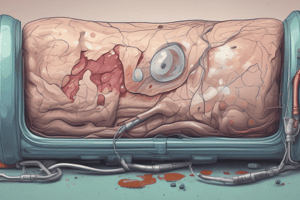Podcast
Questions and Answers
How does stress influence wound healing?
How does stress influence wound healing?
- It can promote faster healing due to increased adrenaline.
- It impairs healing by triggering sympathetic nervous system responses. (correct)
- It has no effect on wound healing.
- It solely affects the nutritional intake of the patient.
What role does tissue oxygenation play in wound healing?
What role does tissue oxygenation play in wound healing?
- It ensures the wound receives oxygen and nutrients while removing waste. (correct)
- It aids in blood circulation to remove excess blood.
- It has no notable impact on the healing process.
- It supplies the wound with toxins necessary for repair.
Which factor is critical for optimal wound healing related to nutrition?
Which factor is critical for optimal wound healing related to nutrition?
- Lack of hydration has no effect on healing.
- Excessive calorie consumption.
- A balanced intake of vitamins and minerals. (correct)
- High protein intake is counterproductive.
In what way does advanced age affect the wound healing process?
In what way does advanced age affect the wound healing process?
Which of the following can negatively influence medication's impact on wound healing?
Which of the following can negatively influence medication's impact on wound healing?
What does the 'T' in the TIME acronym for wound assessment stand for?
What does the 'T' in the TIME acronym for wound assessment stand for?
Which type of tissue appears hard, dry, and black, indicating it's nonviable?
Which type of tissue appears hard, dry, and black, indicating it's nonviable?
What indicates a local infection in wound healing?
What indicates a local infection in wound healing?
Moisture balance in wound healing is essential because it:
Moisture balance in wound healing is essential because it:
What effect does advanced age have on wound healing?
What effect does advanced age have on wound healing?
Which statement about nutrition and wound healing is accurate?
Which statement about nutrition and wound healing is accurate?
Which factor can negatively impact tissue oxygenation during wound healing?
Which factor can negatively impact tissue oxygenation during wound healing?
What is the role of exudate in wound healing?
What is the role of exudate in wound healing?
Which nutrient is critical for effective wound healing due to its role in collagen synthesis and immune function?
Which nutrient is critical for effective wound healing due to its role in collagen synthesis and immune function?
How does nicotine affect the healing process in wounds?
How does nicotine affect the healing process in wounds?
What is the recommended serum albumin level to indicate good nutritional status prior to wound healing?
What is the recommended serum albumin level to indicate good nutritional status prior to wound healing?
Why does loss of dermal and subcutaneous mass increase the risk of pressure-induced tissue injury?
Why does loss of dermal and subcutaneous mass increase the risk of pressure-induced tissue injury?
What complication may arise from diabetes that significantly affects wound healing?
What complication may arise from diabetes that significantly affects wound healing?
What role does adequate hydration play in wound healing?
What role does adequate hydration play in wound healing?
What impact does advanced age have on the nutritional status of elderly individuals in relation to wound healing?
What impact does advanced age have on the nutritional status of elderly individuals in relation to wound healing?
What is the effect of corticosteroids on the inflammatory response necessary for wound healing?
What is the effect of corticosteroids on the inflammatory response necessary for wound healing?
Which vitamin deficiency is least likely to be problematic due to its storage properties in the body?
Which vitamin deficiency is least likely to be problematic due to its storage properties in the body?
How can chronic wounds affect dietary needs?
How can chronic wounds affect dietary needs?
Flashcards
TIME acronym for wound assessment
TIME acronym for wound assessment
A clinical tool for systematic wound assessment and documentation, which includes Tissue, Infection/Inflammation, Moisture balance, and Edges/Epithelial advancement
Viable tissue
Viable tissue
Healthy living tissue that protects the wound.
Non-viable tissue
Non-viable tissue
Dead tissue that needs to be removed (debrided) to promote healing
Epithelial tissue
Epithelial tissue
Signup and view all the flashcards
Granulating tissue
Granulating tissue
Signup and view all the flashcards
Local infection
Local infection
Signup and view all the flashcards
Contamination
Contamination
Signup and view all the flashcards
Moisture balance
Moisture balance
Signup and view all the flashcards
Wound Healing Phases
Wound Healing Phases
Signup and view all the flashcards
Proliferative Phase of Healing
Proliferative Phase of Healing
Signup and view all the flashcards
Maturation Phase of Healing
Maturation Phase of Healing
Signup and view all the flashcards
Factors Affecting Wound Healing
Factors Affecting Wound Healing
Signup and view all the flashcards
Tissue Oxygenation in Wound Healing
Tissue Oxygenation in Wound Healing
Signup and view all the flashcards
Elderly Malnutrition Risk
Elderly Malnutrition Risk
Signup and view all the flashcards
Protein Deficiency in Healing
Protein Deficiency in Healing
Signup and view all the flashcards
Vitamin C & Wound Healing
Vitamin C & Wound Healing
Signup and view all the flashcards
Vitamin A & Wound Healing
Vitamin A & Wound Healing
Signup and view all the flashcards
Corticosteroids & Wound Healing
Corticosteroids & Wound Healing
Signup and view all the flashcards
Smoking & Wound Healing
Smoking & Wound Healing
Signup and view all the flashcards
Diabetes & Wound Healing
Diabetes & Wound Healing
Signup and view all the flashcards
Infection & Wound Healing
Infection & Wound Healing
Signup and view all the flashcards
Wound Dehydration & Healing
Wound Dehydration & Healing
Signup and view all the flashcards
Wound Assessment
Wound Assessment
Signup and view all the flashcards
Study Notes
Wound Care for Clinical Nursing
- This lecture covers wound care for clinical nursing
- The lecture spans 83 hours
- Topics include: assessing and identifying wounds, planning wound care, implementing wound care, and evaluating outcomes of nursing actions
Unit One: Assessing and Identifying Wounds
-
Contents:
- Basic wound concepts
- Types of wounds
- Wound healing process phases
- Factors affecting wound healing
- Wound assessment
- Wound debridement
- Dressing material identification
- Wound dressing
-
Learning Objectives:
- Define wounds and their classifications
- Understand the wound healing process
- Identify factors impacting wound healing
- Assess and debride wounds
- Prepare wound dressing materials
- Demonstrate wound dressing techniques
Skin
- The skin is the largest organ, acting as an interface between the body and the environment
- It's the first line of defense, protecting internal organs and their systems
- Skin appearance has significant psychosocial impact on well-being
Skin Thickness and Characteristics
- Skin thickness varies from 1/50th of an inch on eyelids to 1/3rd of an inch on palms/soles
- Specialized cells form nails and hair
- Skin pH (4.5-5.5) maintains a protective mantle, supporting normal flora
Vital Functions of the Skin
- Regulates body temperature
- Detects touch, pressure, and pain
- Prevents excessive fluid loss
- Acts as an excretory organ
- Protects inner tissues from external invasion
Skin Layers
- Epidermis: Outermost, thin, avascular layer
- Dermal-Epidermal Junction: Provides structural support for exchange of fluids and cells between layers; features rete ridges (finger-like projections). Decreases with age, potentially leading to skin tears in older individuals
Wound Classification
- Based on duration (acute vs. chronic)
- Based on cause (surgical vs. accidental)
- Based on cleanliness (clean, clean-contaminated, contaminated, dirty/infected)
- Based on skin integrity (open vs. closed)
Wound Classification by Thickness of Skin Loss
- Superficial epidermal (first degree): Contained to epidermis
- Partial-thickness (first to second degree): Involves epidermis and upper dermis
- Deep (second degree): Involves epidermis and deep dermis
- Full thickness (third degree): Through epidermis, dermis, and into subcutaneous tissue
- Fourth degree: Deeper still, extending into muscle and bone
The RYB Wound Classification System
- A color system assists nurses in assessing wounds and directing their treatment
- Red wounds: Are the color of normal granulation tissues, active phase of wound healing; need moist, protected environment.
- Yellow wounds: Have fibrinous or purulent exudate; require cleansing and debridement.
- Black wounds: Have necrotic tissue ("eschar"): necessitate debridement
- Mixed color wounds are common, requiring treatment of the worst color first
Phases of Wound Healing
- Defensive (inflammatory): Occurs immediately after injury (3-4 days). Characterized by hemostasis (cessation of bleeding), inflammation (body's defense). Vascular and cellular reactions are involved.
- Proliferative: Overlaps inflammatory phase; occurs 2-4 days post-injury, lasting 15-16 days. Key processes include collagen deposition, angiogenesis (new blood vessel formation), granulation tissue development, and wound contraction.
- Maturation (differentiation): Final stage, beginning 21 days post-injury, potentially lasting up to two years, as the scar tissue remodels/changes.
Factors Affecting Wound Healing
- Tissue oxygenation: Blood flow essential for nutrients and waste removal
- Stress: Disrupts healing due to nervous & hormonal system responses
- Advanced age: Affects healing rate, collagen, and epidermal turnover.
- Nutrition: Crucial for adequate nutrient supply
- Infection: Impedes healing
- Lifestyle (e.g., smoking): Impacts blood flow and oxygen transport
- Dehydration: Poor healing
- Age: Impacts repair rate, tensile strength, and collagen deposition
Wound Assessment
- Systematic method for wound record use.
- Measurements, inflammation, contraction, epithelialization, necrotic and drainage, and exudate characteristics are assessed
- TIME acronym (Tissue, Infection/Inflammation, Moisture balance, Edges) is utilized for comprehensive evaluation
- Note tissue viability: (epidermal, granulating, slough, necrotic), distinguishing elements to protect/debride
Further Wound Assessment Details
- Assessing wound exudate color, common type, and significance.
- Peri-wound evaluation examining for cellulitis, edema, maceration, or other conditions.
- Pain assessment, addressing possible sources, providing context for therapeutic interventions
- Laboratory data (cultures, WBC count, albumin) inform causative organisms and infection severity
Wound Complications
- Infection (sepsis, osteomyelitis)
- Wound dehydration (impacting healing)
Other Important Factors
- Diabetes: High glucose levels impair collagen deposition and wound healing
Studying That Suits You
Use AI to generate personalized quizzes and flashcards to suit your learning preferences.





